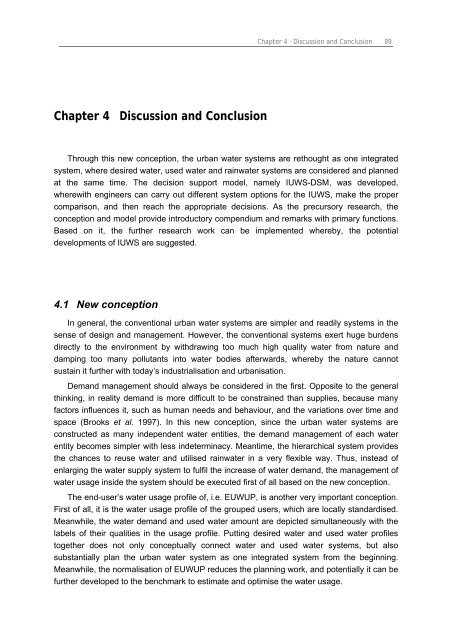Chapter 3 Decision Support Model (IUWS-DSM) - Tubdok
Chapter 3 Decision Support Model (IUWS-DSM) - Tubdok
Chapter 3 Decision Support Model (IUWS-DSM) - Tubdok
You also want an ePaper? Increase the reach of your titles
YUMPU automatically turns print PDFs into web optimized ePapers that Google loves.
<strong>Chapter</strong> 4 Discussion and Conclusion<br />
<strong>Chapter</strong> 4 · Discussion and Conclusion 89<br />
Through this new conception, the urban water systems are rethought as one integrated<br />
system, where desired water, used water and rainwater systems are considered and planned<br />
at the same time. The decision support model, namely <strong>IUWS</strong>-<strong>DSM</strong>, was developed,<br />
wherewith engineers can carry out different system options for the <strong>IUWS</strong>, make the proper<br />
comparison, and then reach the appropriate decisions. As the precursory research, the<br />
conception and model provide introductory compendium and remarks with primary functions.<br />
Based on it, the further research work can be implemented whereby, the potential<br />
developments of <strong>IUWS</strong> are suggested.<br />
4.1 New conception<br />
In general, the conventional urban water systems are simpler and readily systems in the<br />
sense of design and management. However, the conventional systems exert huge burdens<br />
directly to the environment by withdrawing too much high quality water from nature and<br />
damping too many pollutants into water bodies afterwards, whereby the nature cannot<br />
sustain it further with today’s industrialisation and urbanisation.<br />
Demand management should always be considered in the first. Opposite to the general<br />
thinking, in reality demand is more difficult to be constrained than supplies, because many<br />
factors influences it, such as human needs and behaviour, and the variations over time and<br />
space (Brooks et al. 1997). In this new conception, since the urban water systems are<br />
constructed as many independent water entities, the demand management of each water<br />
entity becomes simpler with less indeterminacy. Meantime, the hierarchical system provides<br />
the chances to reuse water and utilised rainwater in a very flexible way. Thus, instead of<br />
enlarging the water supply system to fulfil the increase of water demand, the management of<br />
water usage inside the system should be executed first of all based on the new conception.<br />
The end-user’s water usage profile of, i.e. EUWUP, is another very important conception.<br />
First of all, it is the water usage profile of the grouped users, which are locally standardised.<br />
Meanwhile, the water demand and used water amount are depicted simultaneously with the<br />
labels of their qualities in the usage profile. Putting desired water and used water profiles<br />
together does not only conceptually connect water and used water systems, but also<br />
substantially plan the urban water system as one integrated system from the beginning.<br />
Meanwhile, the normalisation of EUWUP reduces the planning work, and potentially it can be<br />
further developed to the benchmark to estimate and optimise the water usage.

















